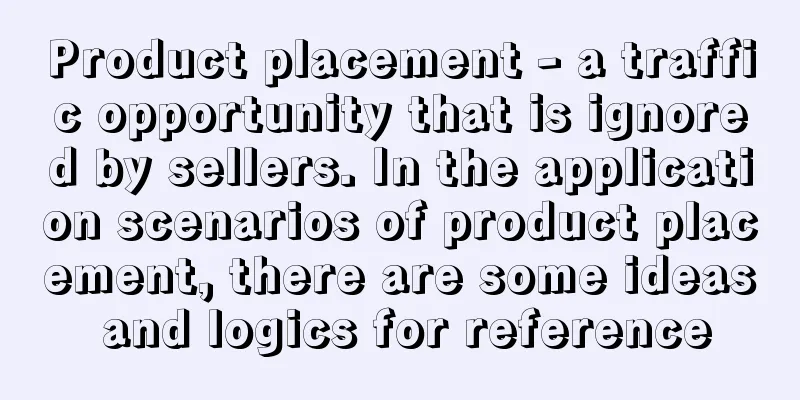|
As far as the current development of Amazon's advertising is concerned, product promotion advertising is the most studied method of delivery. However, most sellers focus on keyword delivery. In fact, there are many techniques in product delivery that are really worth exploring. This time we will try our best to straighten out the logical thinking of product delivery, so that under the guidance of specific purposes, with the help of these two sets of techniques of keyword delivery and product delivery, we can better use this advertising tool of product promotion.
The value and application scenarios of product placement
Currently, Amazon's three major advertising tools, Product Promotion (SP), Brand Promotion (SB) and Display Promotion (SD), all have product placement branches. SP and SB are product placements, while SD is content-related placements.
Product placement is divided into category placement and ASIN placement. Categories can be refined and ASINs can be expanded, so how to expand is particularly important.
The categories of products can be the same ASIN, the same scenario, or the complementary application scenarios. The expansion of ASIN can include the same products (your own or your competitor's), products in the same application scenarios, and complementary products.
In terms of the refinement of categories, there is also a set of logic for reference, which focuses on brand, price, star rating and delivery method.
In the application scenarios of product placement, there are some ideas and logics for reference:
Expand audience coverage - Product placement can help sellers effectively improve audience coverage and reach target consumers through products. If you only place keywords, you will miss exposure opportunities to varying degrees depending on the characteristics of category traffic. Therefore, the correct approach is to combine keyword placement and product placement to cover both search traffic and associated traffic.
Break through the keyword bottleneck (keyword ambiguity) - When consumers do not have clearly targeted search terms for the products being sold, the search volume for "precise long-tail terms" is relatively small, or it is difficult for consumers to find innovative products through searches, the use of targeted product placement or similar hot-selling ASINs in the category can achieve a roundabout way to save the country. Break through the keyword bottleneck (product keywords are sensitive words) - When the keywords of the products being sold are sensitive words and the use of keywords is likely to cause the advertising campaign to be shut down, you can use product placement to locate competitor ASINs to solve the product traffic dilemma.
Occupy category node traffic - When consumers in the category like to purchase goods through category nodes, such as fashion, clothing, gifts, etc., you can consider using product placement (placement of similar/related categories), sellers can effectively reach potential consumers. Positioning precise target groups - When there are many market segments in the category and it is difficult to use keywords to distinguish and locate the target consumers you want to reach the most, you can consider using product placement (category refinement, positioning specific ASIN) to screen the target group. For example: price is a significant factor in distinguishing market segments. Achieve cross-selling and up-selling - When the products being sold can be used in combination with other products, or when it is easy for consumers to purchase them at the same time/upgrade them, you can use targeted complementary products and upgraded products (your own) to achieve cross-selling and up-selling. Defending your own traffic - When the products you sell have good exposure and clicks, but the conversion rate is not ideal or you find that there are many competing product ads on your product details page, you can use product placement to target other products in your own store to form traffic defense and traffic closed loop, improve product conversion rate, and enhance your own brand awareness. Seize the traffic of competing products - When the products you sell have similar competitors, you can use product placement to target competing products, so that your products appear on the product details page of competing products and seize the traffic of competing products. When the target competing products have a high natural ranking for certain keywords, your products may also be displayed on the homepage of search results.
Hidden skills of product placement
In the advertising campaign for product placement, even if you are doing an ASIN-targeted advertising campaign, you can see from the advertising results that the product placement ads are not only on the product details page, but also on the top of the search results page and other locations.
Under what circumstances will ads be displayed on the search results page using product placement?
On this search results page, an ASIN with organic ranking meets all the targeting conditions (ASIN, category targeting conditions) set by the advertiser. On this search results page, the carousel ad slot closest to the targeted ASIN
How can we make it easier for products to appear on the search results page?
Targeted delivery of ASINs with natural rankings/higher natural rankings
Bid adjustment: increase the bid for the first page of search results and other positions
***Note: When targeted products appear on the search results page, competition is more intense and you need to carefully control your competitive advantages and disadvantages
Before launching a product launch, first obtain the keyword tags for the product to be launched, and then make a judgment on whether the system has included it, so that your product advertising can be targeted.
The method to obtain keyword tags is as follows
After this step is completed, you can determine the system inclusion status of the current ASIN by placing the ASIN
ASIN traffic is not recommended - this means that ASIN traffic cannot be matched temporarily. If automatic advertising is turned on at this time, similar products are usually not exposed.
The ASIN traffic deviation is large - this indicates that there is a problem with the label in the ASIN traffic part, and the accuracy of the traffic is problematic.
ASIN traffic is consistent - and there are more ASIN recommendations, indicating that Amazon's traffic trend is relatively good in the field of ASIN traffic.
Practical tips for product placement
How to judge whether your product has the potential for commercial launch?
Calculate the data of ASIN in automatic advertising separately and work out its specific ACOS value. Generally, you can compare the comprehensive Acos value of keyword placement at the same time. If the ACOS value of ASIN is relatively small, it is likely suitable for product placement.
How to find the target category and target ASIN for product placement?
Generally, we look for products from three dimensions: the same product, products with the same application scenarios, and complementary products.
Tips for targeting product categories: cross-refinement
After locking in the targetable categories, use the cross-refinement logic to carry out category node targeting delivery. That is, the same category can be delivered simultaneously using different refinement logics.
The refinement logic is mainly based on price, star rating, and delivery method. For example, products with the same price and star rating but different delivery methods are released at the same time. Different refinement combinations will result in completely different data performance. This solution can be used to test the optimal refinement method for the target category.
Tips for ASIN targeting of products: ASIN expansion
For the high-performance ASINs we have found, if they have received more than three orders, we can expand the ASIN distribution to develop more high-performance ASINs. If they have received only one order, we can accurately locate the ASIN and then pull big data to judge the pros and cons of the ASIN.
Traffic analysis of ASIN
The conversion characteristics of the ASIN traffic structure are as follows: standard products and non-standard products. According to the conversion share of the top 3 products in ABA, the conversion share of the top 3 products in the standard product category is basically 20%~30%. For the keywords of non-standard products, the conversion share of the top 3 products is basically no more than 1%.
Consumer purchasing preferences - standardization and personalization, whether consumers have a consensus on judging the quality of products. When describing what specific needs a product should meet, standard products tend to focus on standard functional characteristics, such as the capacity of a power bank (the larger the better) and fast charging (the faster the better). Non-standard products, on the other hand, tend to focus on subjective needs such as style/design/color, and there is no way to say which is better for these needs, as consumers have different preferences.
Traffic characteristics - search traffic and associated traffic, search purchase vs. exhibition purchase, determine the proportion of search traffic/associated traffic. Count the keyword data and ASIN data in automatic advertising. For non-standard products, product placement often performs well. Even in the automatic advertising of many products, the data performance of similar products and related products is better than close matching and broad matching. Therefore, it is very important to do a good job of non-standard products and layout associated traffic through product placement.
Keyword position - the first page of search results and other positions, determine the traffic and conversion ratio of the first page of search results, and decide whether to push the keywords to the first page. Determine whether consumers tend to make final purchase decisions on the first page or the first three pages of search results. If so, when placing ads, we need to try to keep the ad space on the first page or the first three pages, and we need to adopt a strategy of low bidding and high ad position price increase. If consumers tend to buy by browsing the exhibition, they will not make the final purchase decision only on the first page, so grabbing the first page position may have a low cost-effectiveness.
The number of keywords - concentrated or dispersed, the number of product keywords, the number of long-tail keywords, and the traffic volume of long-tail keywords. For standard products, the number of keywords is relatively small and concentrated on the core functions of the product, and consumers tend to buy on the homepage or the first three pages of search results, so it is important to grab the core keyword display share, promote keyword rankings, and block positions. However, for non-standard products, most consumers have personalized needs, so there are all kinds of products, which leads to a large number of keywords searched by consumers. It is not possible to sit back and relax by grabbing 1-2 big words.
Advertising focus of ASINs with different traffic structures
How to use product placement to drive ASIN traffic tags
New products will have much fewer traffic entrances than old products that sell well. If we do ASIN positioning and delivery of competing products, we can often quickly obtain entrances to many traffic words of competitors.
Manual product placement locates competitors or related products, which can trigger ASIN association and obtain keyword tags behind competitors and related product tags
Effectively cooperate with automatic advertising and manual advertising. Automatic advertising is very important because the system may understand the type of traffic suitable for ASIN better than we do. Manual keyword placement and manual product placement are the channels to accurately "label" the product, so I think these three placement methods must be a combination.
How to use product placement to build ASIN-related traffic structure
The traffic structure of ASIN can be analyzed by traffic positioning method, that is, analyzing the traffic characteristics of ASIN, exploring all possible traffic types and traffic channels of ASIN, and working backwards to determine how to select appropriate advertising types and delivery methods to obtain these types of traffic, so as to achieve the goal of comprehensive traffic coverage.
Purpose of Category and ASIN Placement
Category delivery: Continue to expand traffic in the same category, alternative categories, and complementary categories; continue to deliver advertising groups for ASIN to find high-performance customers searching for ASIN; and bring conversions.
ASIN placement: Bring conversions; continuously optimize ads and improve ad ROAS.
Main sources of targeted merchandise
How to discover your own competing/related products?
Collect ASINs that can be used for advertising through advertising reports
Product placement structure recommendations
Category Targeting - Same Product - Advertising Goal: Expand traffic in the same category, test ASINs with good performance in the category, and then accurately place advertisements in the future. Setting: Select detailed dimensions based on product competitiveness comparison
Category Targeting - Same Application Scenario - Advertising Goal: Expand traffic in adjacent categories, test ASINs with good performance in the categories for precise delivery in the later stage. Advertising Setting: Initial daily budget setting meets 40-60 clicks, and balance budget based on test results in the later stage.
Category Targeting - Complementary Products - Advertising Goal: Expand traffic in complementary categories, test ASINs with good performance in the categories for precise advertising in the later stage. Advertisement Setting: Initial daily budget setting meets 40-60 clicks, and balance budget based on test results in the later stage.
ASIN Targeting - Precise Competitive Products - Advertising Goal: Launch precise targeted competitive products to force the weak and seize the traffic of competitive products. Advertising Setting: Competitive ASINs that have undergone competitiveness comparison or data verification can be given high bids and high budgets to strive for more traffic and conversion opportunities.
ASIN targeting - own products - advertising goals: 1) Launch your own products to form a closed loop of traffic and prevent competitors from occupying your advertising position; 2) Use new ASINs or long-tail ASINs for clearing inventory to position your own high-traffic main ASINs to form a situation where old customers bring in new customers. Or use your own high-priced products to position low-priced products to achieve upgraded sales. Advertising settings: It will be more advantageous to launch your own products, and you can give high bids and high budgets.
Common Misunderstandings about Product Launch
Misconception 1: You think that products can only be placed on the product details page, but in fact they can also be placed on the search results page
In an advertising campaign that only places products, you can still see exposure on the search results homepage and other search results. When an ASIN with natural ranking on the search results page meets the product targeting conditions set by the advertiser, the ad may be displayed on the search results page, in the carousel ad slot closest to the targeted ASIN.
Why can product placement be placed on the search results page?
Products are a collection of keywords (tags). Keywords are a collection of similar products.
Misconception 2: I think product placement cannot improve the natural ranking of keywords. In fact, it can, and the effect is very significant.
Why is it that product placement does not improve organic rankings as significantly as keyword placement?
Because the cost of product placement is relatively scattered, it is not as good as concentrating on keyword placement.
Misconception 3: You think you can’t view the keywords when placing a product. Actually, you can. You need to check them through the advertising background or software.
Misconception 4: Thinking that product placement cannot negate keywords. In fact, it can, but it needs to be done at the campaign level.
In order to improve the accuracy of product placement, we can also use negative keywords in product placement advertising activities. It is worth noting that product placement negative keywords need to be operated at the advertising campaign level.
The relationship between product placement and keywords
Keyword placement and product placement meet different consumer shopping paths
The synergy between keyword placement and product placement
The complementary effects of keyword placement and product placement
How to link product placement with keywords
Scenario 1: Expand competitor ASIN keywords through product placement
Product placement: Place an order on competitor ASIN Filter out the ASINs of competitive products with outstanding performance Check product relevance Reverse search for competitor keywords Determine keyword relevance and place orders
Scenario 2: Promote core keyword rankings through product placement
Product placement: Place an order on competitor ASIN Search results page markup Query the search terms Determine keyword relevance Keyword placement (precision) pushes keyword ranking
Scenario 3: Expand product placement (category) through keyword placement
Keyword placement Discover related product keywords that perform well Analyze consumer cross-buying behavior Place related products in the category
Scenario 4: Expand product placement through keyword placement (competing ASIN)
Keyword placement Discover the top performing competitor brands/function search terms Search for related brands/functions Determine the competitive advantage of your product Product placement: Target competitor ASIN
|










